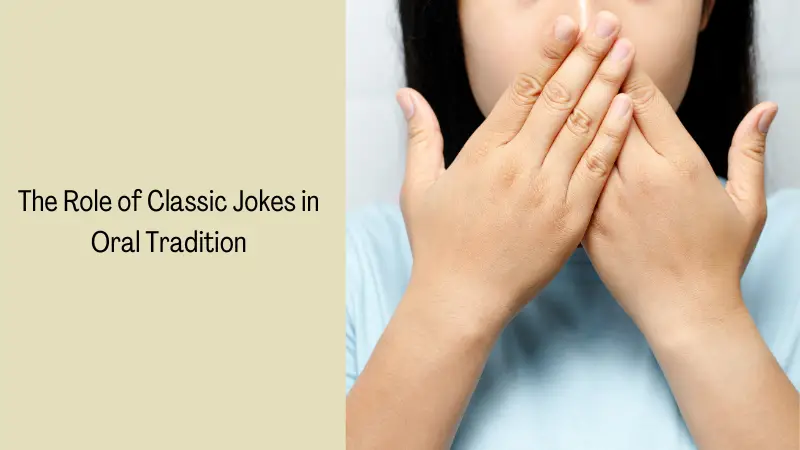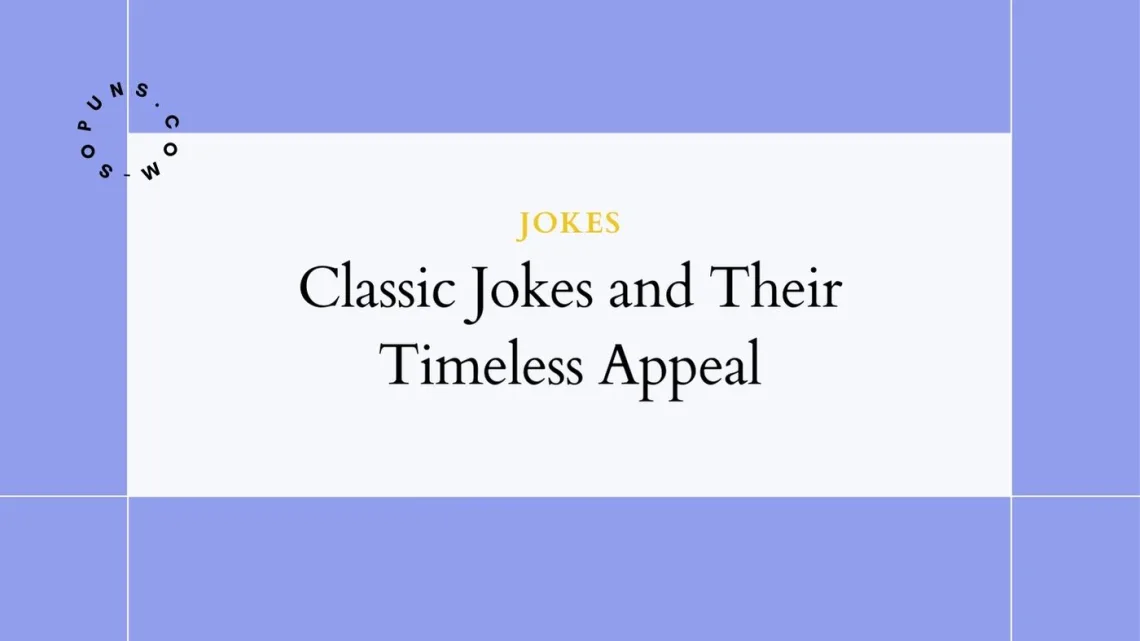A good joke stands the test of time. While humor trends come and go, certain classic jokes remain etched in public memory and continue eliciting hearty laughs no matter how many times we hear them. What gives these iconic jokes their enduring charm and appeal?
The Hallmarks of Classic Joke Greatness
Classic jokes have a timeless, universal quality that transcends generations. Their humor stems from universally relatable topics like marriage, family life, interactions with in-laws, workplace frustrations, and experiences we can all identify with. Even when using dated cultural references, the core humor remains relevant.
Structurally, many classic jokes follow the typical setup-punchline format with a sudden twist or an unexpected play on words that surprise the listener. The unexpected incongruity triggers laughter. Simple, short jokes with everyday language work best for retention and repetition. Drawing on stereotypes also gives these jokes a broad appeal.
Classic jokes endure because they are incredibly quotable. The humor is distilled into pithy one-liners or stories short enough to remember. People relish opportunities to insert these zingers into the conversation. Comedically gifted raconteurs like Groucho Marx and Rodney Dangerfield built their personas around the rapid-fire delivery of classic one-liners.
Timeless Crowd-Pleasers: Anthology of Classic Jokes
Let’s revisit some cherished classics that have stood the test of time:
“Take my wife, please.” Attributed to Henny Youngman, this quip pokes fun at marriage through wordplay. It’s short, quotable, and exploits the stereotype of the nagging wife.
“Why did the chicken cross the road?” “To get to the other side.” This riddle epitomizes the unexpected anti-climatic punchline. Despite its age, it remains widely known.
“Doctor, doctor…” This setup elicits common doctor-related puns. For example: “Doctor, doctor, I feel like a pair of curtains.” “Pull yourself together!” The corniness adds to the charm.
Knock-knock jokes follow a classic call-and-response structure with a punny punchline. “Knock knock. Who’s there? Boo. Boo who? No need to cry, it’s just a joke!” These cheesy jokes appeal to kids but remain nostalgic classics for adults.
One-liners like “I’ve had amnesia for as long as I can remember” and “Always borrow money from a pessimist. They’ll never expect it back” use oxymorons and unexpected logic for laughs. Their quotability and shareability made them enduring classics.
The Backstory Behind the Jokes
To appreciate iconic jokes, it helps to understand their origins. “Take my wife, please” emerged in the Borscht Belt comedy circuit during the 1920s-1940s. This was the heyday of rapid-fire, self-deprecating Jewish humor from the likes of Henny Youngman and Rodney Dangerfield performed in front of tough NYC crowds.
The chicken crossing the road joke first appeared in 1847, but really took off after behavioral scientists started analyzing “Why did the chicken cross the road?” as a model of the human decision-making process, adding a layer of academia-skewering meta-humor.
Doctor jokes parody the incomprehensible medical jargon doctors use and the discomfort of medical exams. They likely gained prominence in the early 1900s when healthcare became more standardized and doctors achieved greater authority.
Knock-knock jokes first surfaced in the early 1900s on college campuses, then gained wider appeal through radio and TV shows like Abbott and Costello. Their repetitive structure made them a playground for verbal humor.
One-liner jokes were popularized in the 1950s and 60s through iconic comedians known for rapid-fire deliveries – Henny Youngman, Rodney Dangerfield, Groucho Marx, and Johnny Carson among others. Late-night TV provided a platform to showcase their sharp wit.
Modern Spin on Old Laughs
While classic jokes endure, they evolve with the times. Comedians adapt them by giving these old jokes modern twists and local spins for different audiences.
References get updated – “My wife asked me to pass the TV remote, so I changed channels for her” or “Doctor, Doctor, I read on Facebook…” Knock-knock jokes add contemporary culture “Knock knock. Who’s there? Justin. Justin who? Justin Bieber!”
Pop culture personalities become targets for classic joke formulas_ “What do you call Kim Kardashian crossed with an alien? An attention-seeking missile!”_ The structures stay familiar, but the content gets a refresh.
Comics riff on classic jokes to offer social commentary. “I identify as vaccinated. I took two jabs of tequila, so I’m fully Pfizered now.” The humor breathes new life into stale jokes.
Regional comics incorporate local flavor. “Knock knock. Who’s there? Europe. Europe who? No, you’re a peein’! I’m Nepalese” works for crowds in Asia. Comedians tailor classics to connect with their audiences.
No matter how many times we hear them, classic jokes offer comfort through their familiarity. Meanwhile, skilled comics keep them fresh by evolving the material for new generations. This winning formula ensures these timeless classics will continue cracking us up indefinitely.
The Role of Classic Jokes in Oral Tradition
Classic jokes are passed verbally from person to person, which enhances their nostalgic appeal. Telling and retelling them strengthens social bonds. Friends might exchange familiar knock-knock jokes as a way of connecting. Grandparents delight grandkids by performing their favorite classics. Trotting out well-worn one-liners signals membership in a group.
Classic jokes get woven into family lore. My uncle still tells the same “Take my wife” joke at every family reunion, much to my aunt’s mock exasperation. We cherish these recurring bits as touchstones of our shared history.

Before mass media, jokes spread slowly through oral retellings. Some trace the chicken crossing the road joke to a magazine article in 1847, but it likely circulated orally for decades prior. Such formulas existed as improvised folk humor long before documentation. Repeated hearings allowed jokes to evolve into enduring classics.
The oral transmission allows for modification and regional variations. Knock-knock jokes with localized cultural references emerge organically and get incorporated into local tradition. Comedians develop unique deliveries that enhance the jokes’ oral appeal. Laughing together at familiar favorites strengthens feelings of belonging and connection.
Famous Comedians Keep Classic Jokes Alive
Certain celebrities are inextricably linked with the classic jokes they perform. Without Groucho Marx stating “I refuse to join any club that would have me as a member”, would the joke endure so strongly? His persona is a big reason why that joke remains iconic.
Johnny Carson’s deadpan delivery sold simple one-liners like “If life was fair, Elvis would be alive and all the impersonators would be dead”. The jokes grew iconic because of his comedic charisma.
Rodney Dangerfield’s “I don’t get no respect” refrain perfectly delivered self-deprecating one-liners like “I looked up my family tree – and found out I was the sap”. His signature style immortalized such classics.
Comedians also introduce new jokes that gain instant classic status due to their fame. Rickles roasting Elvis as having “sideburns going back to hoodlum times” or Dangerfield’s “I told my dentist my teeth are going yellow. He told me to wear a brown tie” became classics because of the comics’ beloved personas.
Certain performers have a talent for revamping old jokes in a fresh way. Bette Midler’s saucy twist on “Take My Wife” or Richard Pryor’s raw reinvention of old punchlines showcase how gifted comics can rework classics and create new versions that also gain classic status.
The Universal Humor Embedded in Classic Jokes
Classic jokes gain universal appeal because they tap into shared human experiences and foibles we can all identify with. Family life, marriage, and parent-child relationships provide endless fodder because they provoke such universal feelings. “I asked my mother if I was a gifted child… she said they certainly wouldn’t have paid for me” could apply to almost anyone’s childhood.
Workplace humor also resonates widely. “My boss arrived at work in a brand-new Lamborghini. I said, ‘Wow, that’s an amazing car!’ He said, ‘Thanks, it was an amazing weekend with your wife'” This taps into universal employee resentment.
Ethnic humor functions similarly – “What do you call an Irishman who knows how to control his drinking? A Scot!” Stereotypes provoke recognition across cultures.
The simplest classics amuse kids and adults alike. Knock-knock jokes require no sophistication to enjoy. Funny names like “Amanda Huggenkiss” get laughs from all. Fart humor appeals across age groups. Slapstick works for all languages and cultures. Simple, elemental humor delivers universal laughs.
By tapping into experiences we can all relate to across cultures, classic jokes create an intimate sense of recognition that amplifies their humor and nostalgia. Their universality makes them timeless.
Put Your Own Spin on Classic Jokes
You can reinvent classic jokes to fit different moods and occasions:
Romantic twist – “Knock knock. Who’s there? Olive. Olive who? Olive you so much, Valentine!”
Birthday zinger – “I’m so old, I received the very first knock-knock joke on my 10th birthday”
Parenting joke – “What does a mom say when she enters a teen’s messy room? Knock knock. Who’s there? Not you, clean this up!”
Topical joke – “Why doesn’t Donald Trump mind knock-knock jokes? Because he can always build another door and make Mexico pay for it”
Self-deprecating joke – “My memory is so bad I forgot my entire knock-knock joke halfway through telling it”
Cheesy cooking joke – “Knock knock. Who’s there? Lettuce. Lettuce who? Lettuce in and we’ll have some dinner”
Corny kids’ joke – “Knock knock. Who’s there? Cows go. Cows go who? No silly, cows go MOO!”
Put your creative spin on classics to craft jokes for any situation. The familiar frameworks make it easy to generate a personalized laugh.
Conclusion
Classic jokes have an enduring appeal because they tap into universal human experiences in a short, memorable format using surprise and wordplay that prompts strong humor recognition. Comedians revive them by updating cultural references or adding regional spins. Their inherent nostalgia and connection to oral tradition enhance their longevity. With limitless potential for adaption, these classics will continue making people laugh through the ages. Their simplicity and relatable humor remain timeless.






No Comments